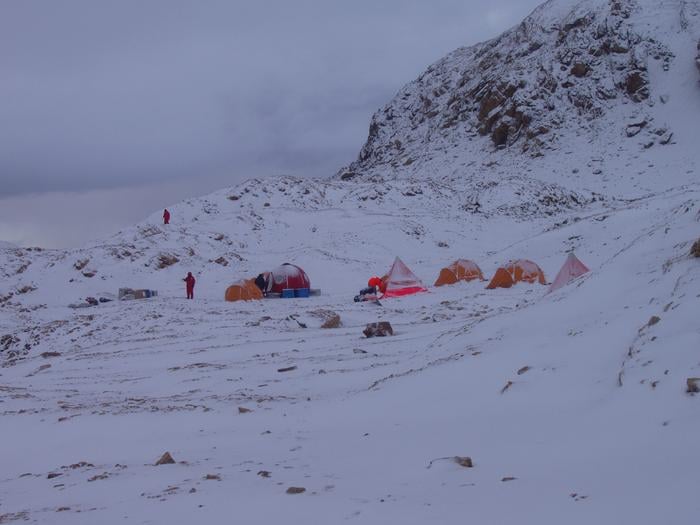The barren, windswept landscapes of Antarctica might appear nearly lifeless to the casual observer, but new research reveals these seemingly desolate soils harbor surprisingly rich communities of microorganisms working together in ways scientists never expected.
This discovery challenges long-held assumptions about biodiversity in Earth’s most extreme environments and suggests we’ve been dramatically underestimating life’s presence on the frozen continent.
German researchers have uncovered complex networks of bacteria and single-celled organisms thriving in nutrient-poor, freeze-dried soils where nothing should survive. Their findings, published yesterday in Frontiers in Microbiology, reveal that cooperation between different microbes – rather than competition – appears to be the key to survival in Antarctica’s harshest environments.
Thriving Where Nothing Should
The research team, led by Dr. Dirk Wagner from the GFZ Helmholtz Centre for Geosciences, collected soil samples at various distances from a retreating glacier in East Antarctica’s Larsemann Hills. Using advanced DNA analysis techniques, they separated genetic material from living organisms from that of dead ones, creating a detailed map of microbial communities.
“Here we reveal unexpectedly abundant and diverse microbial community even in these driest, coldest, and nutrient-poorest of soils, which suggest that biodiversity estimates in Antarctic soils may be greatly underestimated,” said Wagner, the study’s corresponding author.
What they found was astonishing: 2,829 genetically distinct species in soil that, by all conventional measures, should be nearly sterile. Even more surprisingly, these weren’t simple, isolated organisms but interconnected communities working together to survive.
Strength Through Partnership
The researchers discovered numerous examples of microbes with complementary abilities forming partnerships that help each other survive Antarctica’s brutal conditions. These relationships exist along a spectrum from casual roommates to deeply interdependent allies.
“We detected previously unrecognized associations between bacteria and eukaryotes, for example between certain green algae and bacteria, which may promote nutrient exchange. We also found consistent co-occurrence of certain fungi and actinobacteria, which suggests that these fungi could provide carbon for the bacteria by degrading organic matter,” explained Wagner.
This phenomenon mirrors what anarchist geographer Prince Peter Kropotkin observed in Siberia over a century ago – that cooperation, not just competition, drives evolution, especially in harsh environments. His observations formed the foundation for concepts like mutualism and altruism in evolutionary biology.
A Dynamic Timeline Written in the Soil
The research site offered a unique window into how these communities form and evolve. By taking samples at increasing distances from the glacier’s edge, scientists created a timeline showing how microbes colonize newly exposed ground – from pioneer species to complex networks.
Close to the glacier’s edge, where soil had been recently exposed, specialized “cold-loving” fungi dominated. These pioneers help create the first stages of soil formation, preparing the ground for other species to establish themselves.
Each location along this timeline had its own unique set of species. The researchers also found that microbial diversity was typically highest in the top soil layer and decreased with depth – though some hardy species thrived deeper underground.
Methodological Breakthrough
A key innovation in this study was the ability to distinguish between DNA from living organisms (intracellular DNA or iDNA) and genetic material from dead organisms (extracellular DNA or eDNA). This approach allowed researchers to “see” both the current living community and preserved remnants of past inhabitants.
The technique revealed that about 40% of the species were present only as eDNA – genetic ghosts from past communities. Bacterial diversity was also substantially higher than eukaryotic diversity, with bacteria outnumbering eukaryotes (organisms with cell nuclei) by more than 10 to 1.
Implications Beyond Antarctica
The findings suggest several important implications:
- Current biodiversity estimates for Antarctica may need significant upward revision
- Microbial partnerships between bacteria and eukaryotes are crucial for colonizing extreme environments
- These symbiotic relationships help transform harsh environments over time, making them more hospitable to a wider range of life
- The techniques used could help identify potential habitats for life on other planets with extreme conditions
The study suggests that certain partnerships between green algae and bacteria may promote nutrient exchange in environments where resources are vanishingly scarce. Other relationships, like those between certain fungi and actinobacteria, appear to optimize resource utilization through specialized roles.
“Our results indicate that microbial survival in extreme Antarctic habitats may be made possible by tightly linked consortia of species that optimize the utilization of resources,” concluded Wagner.
What’s particularly fascinating is how this mirrors Kropotkin’s observations about cooperation being essential in harsh climates. Just as he observed Siberian animals working together to survive brutal winters, Antarctic microbes have evolved complex cooperative strategies rather than simply competing.
As climate change continues to affect Antarctica, causing more glacial retreat and exposing new terrain, understanding how these microbial communities colonize and transform barren landscapes will become increasingly important. The intricate dance of cooperation that allows life to thrive in Earth’s most extreme environment may hold valuable lessons for how ecosystems recover from disturbance – and perhaps even how life might establish itself beyond our planet.
If our reporting has informed or inspired you, please consider making a donation. Every contribution, no matter the size, empowers us to continue delivering accurate, engaging, and trustworthy science and medical news. Independent journalism requires time, effort, and resources—your support ensures we can keep uncovering the stories that matter most to you.
Join us in making knowledge accessible and impactful. Thank you for standing with us!

